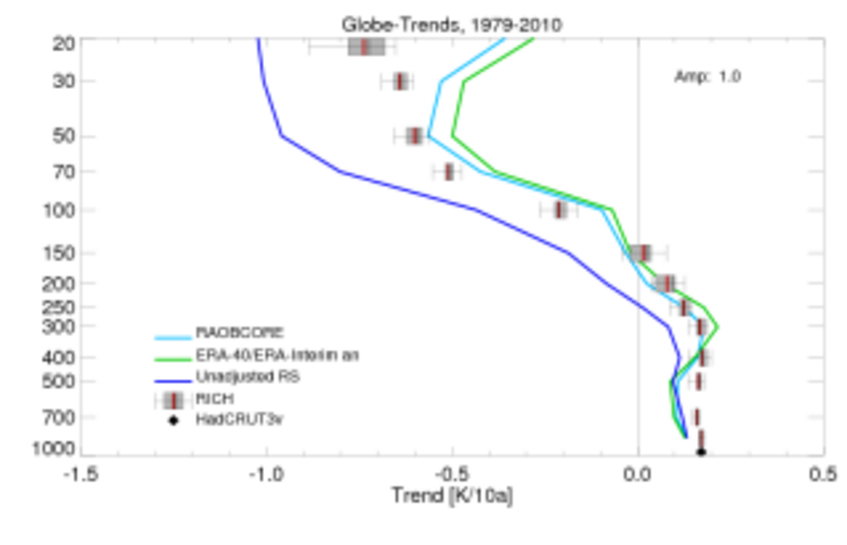RAOBCORE/RICH
Version 1.5.1
December 2015

© IMGW
The RAOBCORE/RICH software package has been developed at University of Vienna since 2004. It has been initially funded by an EU Marie Curie fellowship for Dr. Leopold Haimberger and has then been funded by three FWF projects and two EU FP7 collaborative projects ERA-CLIM and ERA-CLIM2
RAOBCORE and RICH homogeneity adjustments for upper air temperatures from the global radiosonde network. The homogeneity adjustments are required for serious analysis of the upper air climate of the past decades and may be used also for improving the data input for climate data assimilation efforts (often called reanalyses) such as ERA-40 or ERA-Interim.
The adjustment process has two steps:
1) Detection of shifts in existing radiosonde observation time series
2) Estimation of the size of the shifts through comparison with suitable reference series.
Breakpoints in observed radiosonde temperature time series are detected through time series analysis of innovation statistics from ERA-40 (1958-1978) and ERA-Interim (1979 onwards). This means that background forecast time series have been used as reference for break detection. The rationale for this approach is documented in Haimberger (2007) (J. Climate).
The background forecast time series serve well as a reference for break detection but once the breakpoints are known, there are several options for breaksize estimation. We have implemented two options so far:
RAOBCORE
One is to use again the background forecasts as reference. This has been done in the RAOBCORE homogenization method. The current version of radiosonde temperature adjustments is v1.5.1 It basically consists of a single ASCII-file containing the stationIDs and all the adjustments and adjustment dates on 16 pressure levels for 00GMT and 12GMT. The adjustments can be added to the original datasets to yield homogenized time series. A RAOBCORE- v1.5 adjusted temperature anomaly dataset with 10x5 degree resolution can be downloaded as
- ftp://srvx1.img.univie.ac.at/pub/v1.5.1/raobcore15_gridded_2017.nc
- ftp://srvx1.img.univie.ac.at/pub/v1.5.1/
It covers the period 1958-2017. For some users it may be of interest to have also the raw gridded radiosonde data, which are available as
RICH
Using the background forecasts as reference has the disadvantage that the forecasts themselves may be influenced by biases in the radiosonde temperatuers. They may also be influenced by biases from other observing systems, most notably satellites. This problem can be avoided by creating reference series from neighboring radiosonde stations for breakpoint adjustment. This works well as long as the radiosonde network is not too sparse and as long one takes care that only homogeneous pieces of the neighboring time series are used. RICH is superficially documented in Haimberger, Tavolato and Sperka (2008). A more detailed documentation can be found at
A gridded NetCDF formatted RICH-adjusted radiosondet dataset based on RAOBCORE v1.5 can be downloaded as
This file is based on RICH-obs, which uses composites of neighboring observations for break adjustments.
The mean of RICH-tau (v1.5) that uses composites of innovations can be found at
Other formats of RAOBCORE- and RICH adjusted data
The RICH datasets above are means of 32 realizations of RICH based on one realization of RAOBCORE. One can download individual ensemble members of RICH-obs and RICH-tau from
Station time series with monthly and daily resolution are available on request from
Comprehensive radiosonde/PILOT temperature and wind archive on 16 standard pressure levels Within the framework of EU-project ERA-CLIM, a comprehensive radiosonde/PILOT wind archive has been developed. It can be accessed via PANGAEA (http://doi.pangaea). Within the framework of EU-project ERA-CLIM, a comprehensive radiosonde/PILOT wind archive has been developed. It can be accessed via PANGAEA (http://doi.pangaea.de/10.1594/PANGAEA.823617) over their standardized portal. The data, their adjustments and a use case on tropical temperature trends derived from vertical windshear, are published in Ramella-Pralungo et al. 2014a, Ramella-Pralungo and Haimberger, 2014b and Ramella-Pralungo and Haimberger, 2015b
